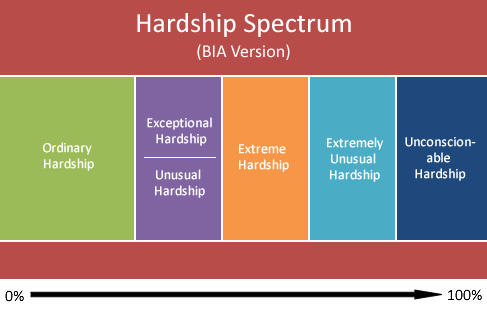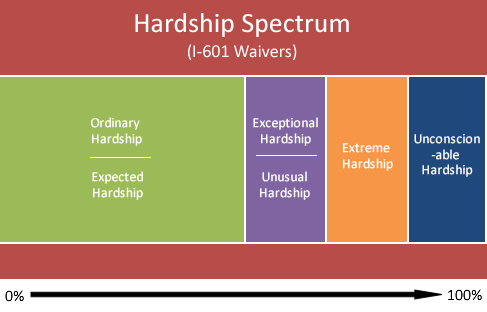Varying Standards For Immigration Court And Agencies
Hardship is an important requirement in deportation cases for undocumented immigrants who are facing removal from the United States at immigration court.
It is also a critical component in permanent residency cases involving consular processing and I-601 family unity waivers.
Suspension Of Deportation
Extreme Hardship

This is the original version of hardship. It is based on a notion of “extreme hardship”.
Used primarily in immigration court matters, it remains the clearest explanation of hardship.
However, it is not the only definition of hardship used in immigration law cases.
On the one hand, the types of evidence needed to demonstrate your qualifying relative’s level of hardship is the same from case-to-case.
Yet, the degree of hardship – i.e., the degree of suffering by a qualifying relatives – that must be supported by your evidence differs from one form of hardship to another.
Puzzled?
You’re not alone.
The graphs below attempt to show the differences in a visual manner.
Cancellation Of Removal (BIA Version)
Exceptional and Extremely Unusual Hardship

Cancellation of Removal replaced Suspension of Deportation in immigration court cases on April 1, 1997. As part of the descent into an age of immigration darkness, the requirement for hardship was changed to “exceptional and extremely unusual” hardship.
The graph above illustrates this change.
This legislative modification mandated a new judicial perspective towards the degree of suffering necessary for immigrants to prevail at their deportation hearings.
In my personal view on the new standard set forth for hardship, the language used by Congress has been wrongly perceived by immigration courts.
Rather, a plain language spectrum of hardship should look like the graph immediately below.
Cancellation Of Removal (Plain Language)
Exceptional and Extremely Unusual Hardship

For more in-depth information on interpreting these three graphs, see How To Understand Deportation Defense: Immigration Court Spectrums Of Hardship.
Family Unity Inadmissibility Waivers
On the other hand, the definition of hardship used by immigration agencies went relatively unchanged from the incorporation of the hardship standard in permanent residency and green card cases.
Until 2016.
At that time, the U.S. Citizenship and Immigration Services (USCIS) announced that it was revising how hardship should be analyzed in Family Unity Inadmissibility Waiver cases.
Based on the changes outlined in its operating manual, the current I-601 Hardship Waiver Spectrum follows the pattern shown below.
I-601 Extreme Hardship

In the USCIS version of hardship, proving the existence of “extreme hardship” remains the standard necessary to win.
New terms – “expected hardship”, “exceptional hardship” and “unusual hardship” – have been added.
Such phraseology represents levels of hardship lower than extreme hardship.
To learn more about what the new USCIS guidelines mean, see The New USCIS I-601 Hardship Waiver Guidelines – What Are The Differences?
Ready to take a serious and honest look at the strengths and weaknesses of your immigration case? Let’s get started with a personalized strategy and planning consultation . . .




